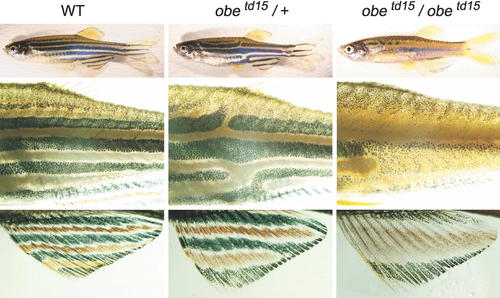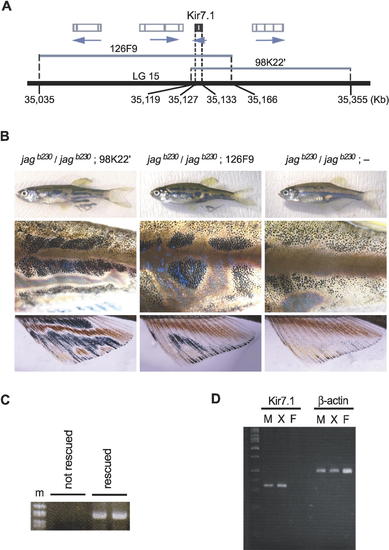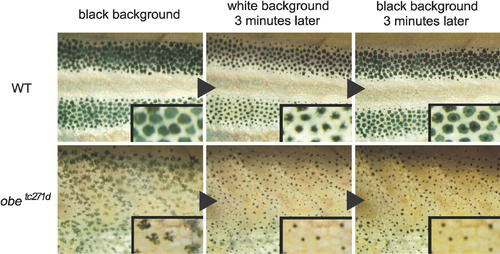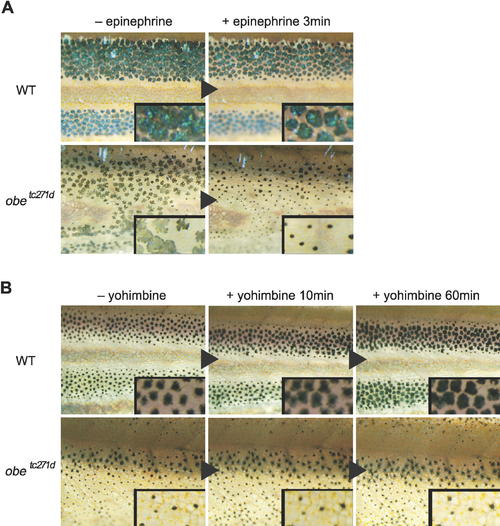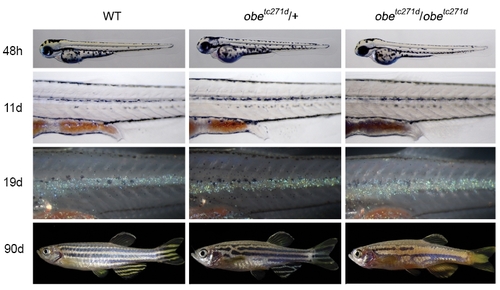- Title
-
Pigment pattern in jaguar/obelix zebrafish is caused by a Kir7.1 mutation: implications for the regulation of melanosome movement
- Authors
- Iwashita, M., Watanabe, M., Ishii, M., Chen, T., Johnson, S.L., Kurachi, Y., Okada, N., and Kondo, S.
- Source
- Full text @ PLoS Biol.
|
Adult Pigment Patterns in jaguar/obelix Mutant Zebrafish. Pigment patterns of whole body (top), trunk (middle), and anal fin (bottom) in wild-type (WT), heterozygous (obetd15/+), and homozygous (obetd15/obetd15) fish. Pigment patterns in all alleles of jaguar/obelix (jagb230, obetc271d, and obetd15) mutants are almost identical (unpublished data). PHENOTYPE:
|
|
Rescue of the jaguar/obelix Phenotype by BAC Injection and Expression of Kir7.1 mRNA. (A) Line diagram depicting the genomic locations of the putative Kir7.1 gene and BAC clones used for the rescue experiments. We used two BAC clones (98K222and 126F9, represented by gray lines) for microinjection. Numbers below the thick black line indicate the positions of the BACs and Kir7.1 on LG15. Open boxes with vertical lines represent the positions and intron-exon structures of putative genes predicted from the ENSEMBL transcript. (B) BAC rescue of pigment pattern in zebrafish mutants. Fertilized eggs from homozygous mutant fish (jagb230 and obetd15) were used in the phenotype rescue experiment. For the injected fish that survived to adulthood, representative pigment patterns of whole body (top), trunk (middle), and anal fin (bottom) are shown. The left panels depict patterns resulting from phenotype rescue using BAC clone 98K222. The middle panels depict patterns resulting from phenotype rescue using BAC clone 126F9. The right panels depict patterns of noninjected fish. All mutant fish (jagb230 and obetd15) rescued by BAC injection had a partial stripe patterns. (C) PCR analysis to confirm BAC integration in the rescued fin. Agarose gel analysis of PCR products derived from a BAC-specific sequence in nonrescued fins (lanes 2 and 3) and rescued fins (lanes 4 and 5). DNA fragments derived from the BAC clones were detected in all rescued fish (n = 6), but no PCR fragment was obtained from DNA of nonrescued fish (n = 6). Molecular mass markers are indicated (m). (D) Expression of Kir7.1 mRNA as detected by single-cell RT-PCR. Agarose gel analysis of RT-PCR products derived from individual melanophore (M), xanthophore (X), or fin dermal cells (F). Molecular mass markers are indicated (m). |
|
Melanophore Aggregation-Dispersion Response to the Change of Background Color. Melanosome aggregation-dispersion in response to a rapid succession of background color change was measured. The upper panels show the responses of melanophores in the trunk of wild-type (WT) fish, and the lower panels show that of mutant fish (obetc271d). The left panels depict the usual state (black background), the middle panels depict melanophores after being sustained for 3 min in a white (light) background, and the right panels depict melanophores after 3 min in a black (dark) background. The wild-type melanophores responded normally to the change of background color (n = 6), whereas mutant fish (jagb230 and obetc271d) melanophores strongly responded to the change of background color from black to white but did not respond to the change from white to black (n = 9 for all). PHENOTYPE:
|
|
Melanophore Response to an α2-Adrenoceptor Agonist or Antagonist. Melanophore response to the agonist epinephrine. Fish were placed in black backgrounds for the duration of the experiment to block the endogenous aggregation signal from sympathetic nerves. The upper panels show the responses of melanophores in the trunk of wild-type fish (WT), and the lower panels show that of mutant fish (obetc271d). Melanophores of wild-type (n = 6) and mutant fish (jagb230 and obetc271d) (n = 12, for all) showed melanosome aggregation when epinephrine was added in the breading water, although the extent of aggregation in the mutant melanophores appeared to be more pronounced than in the wild-type. (B) Melanophore response to the antagonist yohimbine. All fish were kept in an environment with a white background for several minutes (approximately 10 min) prior to addition of antagonist (left panels) and for the duration of the experiment to block endogenous dispersion. The upper panels show the responses of melanophores in the trunk of wild-type (WT) fish, and the lower panels show that of mutant fish (obetc271d). Melanosomes of wild-type fish dispersed after adding the antagonist, because the antagonist blocks the endogenous aggregation signal (middle and right panels) (n = 7). However, in mutant fish (jagb230 and obetc271d), many of the melanophores remained aggregated for a long time (longer than 60 min) (n = 12 for all) (unpublished data). |
|
Pigment patterns of wild-type (WT), heterozygous (obetc271d/+), and homozygous (obetc271d/obetc271d) fish at embryonic (48 h), larval (11 d, 19 d), and adult (90 d) stages. Differences in patterns emerge when adult pigment patterns begin to form around 14 d. Note that the pigment patterns in all alleles of jaguar/obelix mutants are almost identical. PHENOTYPE:
|

